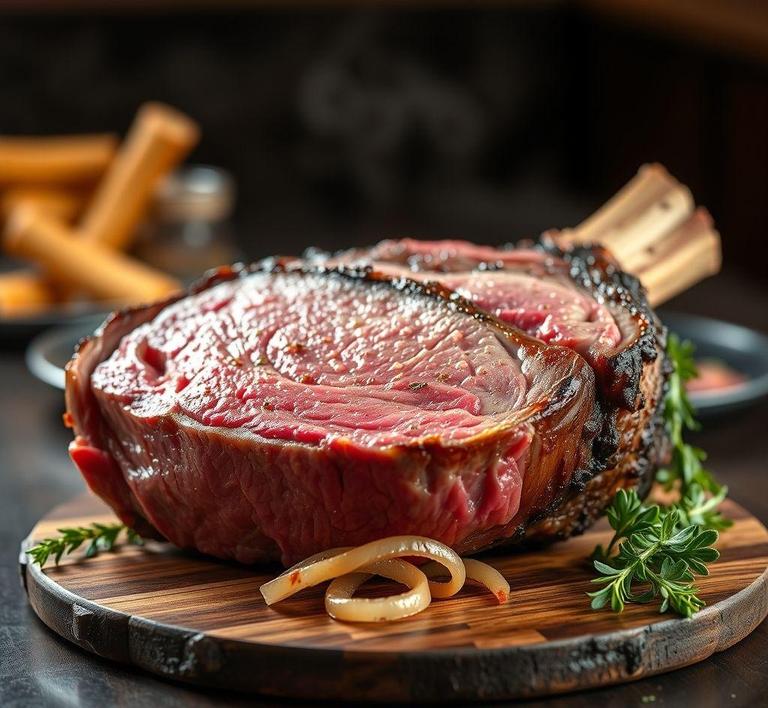If you’ve ever found yourself with leftover prime rib and wondered whether it’s safe to refreeze it, you’re not alone! Refreezing prime rib can be a great way to preserve those delicious, juicy leftovers for another meal, but there are a few important tips to keep in mind. From how to store it properly to ensuring the flavor and texture remain intact, this guide will walk you through everything you need to know to refreeze prime rib without compromising its quality. So, let’s dive into the best methods for refreezing and reheating this premium cut of meat, so you can enjoy it just like the first time!
Can You Refreeze Prime Rib?

Refreezing prime rib is a question that many home cooks and meat enthusiasts often ask. When you buy a prime rib roast, it’s usually a special occasion type of meal, whether for a holiday feast, a family gathering, or a celebration. After the meal, it’s common to have leftovers, and the thought of refreezing those leftovers often crosses your mind. But can you refreeze prime rib without compromising the quality and taste of the meat?
The short answer is yes, you can refreeze prime rib, but with some important caveats to keep in mind. The key factor here is how the meat was handled during the initial freezing, thawing, and storage processes. As with any type of meat, the most crucial part is ensuring that the prime rib is stored correctly to prevent bacteria growth and to retain the meat’s flavor and texture.
Prime rib is a cut of beef prized for its tenderness, marbling, and rich, beefy flavor, making it an expensive and luxurious choice for meals. If not handled properly, refreezing can damage the meat’s texture, leading to a loss of juiciness and tenderness. But when done properly, refreezing leftovers can be a convenient way to preserve the meat for future enjoyment.
How To Refreeze Prime Rib?
Refreezing prime rib is a process that requires careful attention to detail to maintain the meat’s quality. Here’s a step-by-step guide on how to properly refreeze prime rib:
-
Ensure the Meat Has Been Thawed Safely:
The first step in refreezing is to ensure that the prime rib was thawed safely the first time. If you thawed the prime rib in the fridge and it has not been left at room temperature for more than two hours, it is safe to refreeze. Thawing in the refrigerator ensures that the meat stays at a safe temperature (around 40°F or below), reducing the risk of bacterial growth.
-
Avoid Refreezing Meat Multiple Times:
Ideally, you should only refreeze prime rib once. Every time meat is thawed and then refrozen, it goes through a cycle of temperature fluctuation, which can lead to moisture loss, affecting both texture and taste. As the meat refreezes, ice crystals form within the cells, which rupture when the meat is thawed again. This results in the loss of juices, making the meat dryer and tougher.
-
Prepare the Prime Rib for Refreezing:
Before refreezing, it’s best to cut the prime rib into portions that are small enough to be used in future meals. This allows you to defrost only the amount you need, instead of defrosting the entire roast again. For maximum protection against freezer burn, wrap the prime rib tightly in plastic wrap or aluminum foil. For added protection, place the wrapped meat in a heavy-duty freezer bag or vacuum-seal it if you have the equipment to do so.
-
Label and Date the Packaging:
To keep track of how long the prime rib has been in the freezer, it’s important to label the packaging with the date it was refrozen. This way, you’ll know when the meat needs to be used by, and it helps avoid confusion in the future. Prime rib, like other meats, can typically be stored in the freezer for up to 6 months. After that, it may start to lose flavor and quality, even if it is still technically safe to eat.
-
Freeze Quickly and at the Right Temperature:
The faster you can get the prime rib into the freezer after prepping it, the better. The goal is to freeze it solid as quickly as possible to minimize the loss of texture and flavor. Your freezer should be set to 0°F (-18°C) or lower to ensure proper freezing. A faster freeze time helps prevent the formation of large ice crystals, which can cause cell damage to the meat.
Quality Impact
The quality of prime rib can be affected by the refreezing process, especially when it comes to texture and moisture retention. Here’s a closer look at how refreezing prime rib may affect its quality:
Texture
Refreezing prime rib can lead to changes in texture, primarily due to moisture loss. When the prime rib is thawed for the first time, the muscle fibers begin to break down, and some of the moisture that was retained in the meat is lost. If it is refrozen and thawed again, even more moisture is lost as ice crystals form within the meat’s cells. This can result in a drier, less tender texture. Since prime rib is prized for its tenderness, this can significantly diminish the eating experience.
Flavor
While the flavor of refrozen prime rib might not degrade as much as its texture, some subtle changes can occur. The rich, beefy flavor of the prime rib could become a little more muted after refreezing, especially if the meat was wrapped improperly or stored for too long. This is often due to freezer burn, which can occur if air is allowed to reach the meat. Freezer burn results in dehydrated spots on the surface of the meat, which can taste bland or slightly off.
Moisture Loss And Juiciness
One of the most significant issues with refreezing prime rib is moisture loss. When meat is frozen, ice crystals form within the muscle fibers. When it’s thawed, the water that was trapped inside is released, and with each refreeze-thaw cycle, the meat becomes progressively drier. As prime rib is known for its juiciness, this loss of moisture can be especially noticeable.
However, if the prime rib is vacuum-sealed or wrapped well to prevent air from touching the meat, it can help retain some of its moisture and prevent freezer burn. But even with good packaging, the process of refreezing will still have some negative impact on the overall quality.
Appearance
The visual appearance of the prime rib may also suffer from refreezing. As the meat loses moisture, the surface might become slightly more discolored, and the marbling of fat that is characteristic of prime rib may appear less pronounced. This doesn’t affect the flavor, but it could make the meat look less appetizing.
While it’s safe to refreeze prime rib under the right conditions, doing so will likely affect its quality. Refreezing can lead to changes in texture, moisture loss, and a slight decline in flavor. However, if you’ve properly thawed, stored, and handled the meat, the impact might not be as severe.
For the best results, it’s recommended to only refreeze prime rib once and to freeze it in individual portions to minimize waste. Wrapping it tightly to protect it from air exposure and labeling the packaging with the date ensures the meat stays as fresh as possible. If you’re willing to accept some minor loss of quality, refreezing prime rib is a convenient option for preserving leftovers.
In the end, the decision to refreeze prime rib should be based on your preference for convenience versus quality. If you’re saving the prime rib for a future meal and are not overly concerned about minor texture changes, refreezing can be a practical solution. But if you’re seeking the highest-quality dining experience, it’s best to enjoy your prime rib freshly cooked or frozen just once to maintain its integrity.
Is It Safe To Refreeze Prime Rib?
Refreezing prime rib, or any meat for that matter, can be a tricky subject for home cooks and culinary enthusiasts. The decision to refreeze a cooked or raw prime rib comes down to several important factors, including food safety, texture, and flavor quality. So, is it safe? The short answer is yes, but with caveats.
In terms of safety, refreezing prime rib is generally okay as long as certain conditions are met. The meat must have been stored properly and thawed in the refrigerator (never left out at room temperature) before being refrozen. If these conditions are met, it’s unlikely to pose significant health risks, especially when following the appropriate steps for handling the meat. However, each time you refreeze meat, the quality can degrade due to moisture loss, which affects texture and taste.
The key element that determines the safety of refreezing prime rib lies in the temperature control. If the prime rib has been stored at or below 40°F (4°C) during its entire time in the fridge and the freezer, it is safe to refreeze. This temperature range keeps bacteria at bay and ensures that you won’t be inadvertently introducing harmful pathogens into the meat when it’s refrozen.
One of the primary concerns with refreezing meat is that the freezing process alters the muscle fibers in the meat. As the liquid in the meat freezes and expands, it can rupture the cells, causing moisture to escape. When the prime rib is thawed again, it may be drier and tougher than it was initially, which could impact the eating experience. However, as long as the prime rib has been properly frozen, thawed, and refrozen, this change in texture is generally acceptable, though not ideal.
Signs That Prime Rib Should Not Be Refrozen
While refreezing prime rib is possible under the right conditions, there are certain signs that indicate you should avoid refreezing it. These signs are usually related to improper handling or spoilage. Here’s what to watch out for:
- Temperature Abuse: If your prime rib has been left out at room temperature for more than two hours, it should not be refrozen. Bacteria grow rapidly between 40°F and 140°F (4°C and 60°C), and once the meat enters this danger zone, it could be unsafe to consume, even if refrozen later.
- Unpleasant Odor: If the prime rib has a sour or off-putting odor when you check it after thawing, this is a clear sign of bacterial growth or spoilage. Spoiled meat should never be refrozen or consumed. Trust your senses-smell is often the first indicator that something has gone wrong.
- Slimy Texture: After thawing, if the prime rib feels slimy or excessively sticky to the touch, it could be a sign that bacteria have started breaking down the proteins in the meat. Refreezing meat in this condition will only prolong the potential for harmful bacteria to continue multiplying when thawed again.
- Freezer Burn: Although not necessarily a sign that the meat is unsafe, freezer burn can indicate that the prime rib has been improperly stored. If the prime rib shows signs of freezer burn, such as dry, discolored patches on the surface, it may still be safe to eat but will likely have a much poorer texture and flavor. If the prime rib has been refrozen already, it’s best to avoid refreezing it again.
- Significant Time in the Fridge: Prime rib that has been thawed and stored in the fridge for more than 3-4 days should not be refrozen. The longer the meat has been thawed, the more chances bacteria have had to grow, even at refrigerator temperatures.
Common Refreezing Mistakes
Refreezing prime rib often comes with mistakes that can affect the safety and quality of the meat. Here are some of the most common mistakes people make when handling prime rib for refreezing:
- Thawing at Room Temperature: One of the biggest mistakes people make is leaving the prime rib out at room temperature to thaw, which invites bacterial growth. Ideally, meat should be thawed in the refrigerator, where the temperature stays consistent and safe. If you thaw the prime rib at room temperature, bacteria can multiply quickly, leading to potential foodborne illness.
- Refreezing Multiple Times: While it’s safe to refreeze meat once, doing it more than once should be avoided. Each thaw and freeze cycle compromises the meat’s structure, leading to a dry, flavorless experience. Additionally, repeatedly refreezing prime rib increases the risk of bacterial contamination, as the meat may not reach the safe temperature needed to kill harmful pathogens between cycles.
- Improper Wrapping and Packaging: Not properly sealing the prime rib before freezing is another common mistake. Freezer burn, which occurs when the meat is exposed to air, can result in a tough, unpleasant texture. Using airtight packaging such as vacuum-sealed bags or heavy-duty freezer wrap will help prevent freezer burn and preserve the quality of the prime rib.
- Refreezing Meat That Was Not Properly Cooked or Stored: If the prime rib was cooked or stored improperly before it was first frozen, refreezing it won’t make it safe. The initial process of freezing should involve cooking the meat to the appropriate internal temperature and storing it in a temperature-controlled environment.
- Thawing the Prime Rib Too Quickly: It’s important to never thaw meat too quickly in a microwave or under hot water. These methods may not thaw the meat evenly, and they could cause it to warm to unsafe temperatures too quickly. Always allow the prime rib to thaw gradually in the fridge to ensure a safe process.
Tips And Tricks For Refreezing Prime Rib
If you decide to refreeze prime rib, there are some helpful tips and tricks that can ensure you maintain as much flavor and texture as possible:
- Use a Vacuum Sealer: The best way to preserve your prime rib during freezing is to vacuum seal it. Vacuum sealing removes air from the packaging, preventing freezer burn and helping to maintain the meat’s moisture and flavor. If you don’t have a vacuum sealer, be sure to wrap the meat tightly in plastic wrap or aluminum foil, and place it in a heavy-duty freezer bag.
- Label and Date Everything: Always label your prime rib with the date it was frozen and the date it was initially cooked or bought. This will help you keep track of how long it’s been in storage and avoid keeping it in the freezer for too long. Ideally, refrozen prime rib should be used within 4-6 months.
- Cool Prime Rib Before Freezing: If you are freezing leftover prime rib, allow it to cool to room temperature before freezing. Don’t put hot prime rib directly into the freezer, as it can cause the temperature of the freezer to rise, which can affect the quality of other frozen food items.
- Portion the Meat: If you don’t plan on eating the entire prime rib in one sitting, consider cutting it into smaller portions before freezing. This will make it easier to thaw only what you need, and you won’t have to refreeze the entire piece of meat multiple times.
- Thaw Properly Before Reheating: When you’re ready to use your refrozen prime rib, always thaw it in the refrigerator for at least 12-24 hours before reheating. Avoid reheating it directly from frozen to ensure an even warming process and preserve the meat’s juiciness.
Conclusion
In conclusion, refreezing prime rib is safe as long as it’s done with careful attention to food safety guidelines. The meat must be handled properly at all stages-from thawing to freezing to reheating. While it’s not ideal to refreeze prime rib more than once, doing so under the right conditions won’t necessarily result in a dangerous meal, though it may affect the meat’s flavor and texture. Always monitor the quality of the meat carefully, checking for signs of spoilage, and follow best practices for freezing, thawing, and refreezing to ensure that your prime rib remains as delicious as possible. By following these tips, you can confidently refreeze prime rib and enjoy it later with minimal loss of quality.


